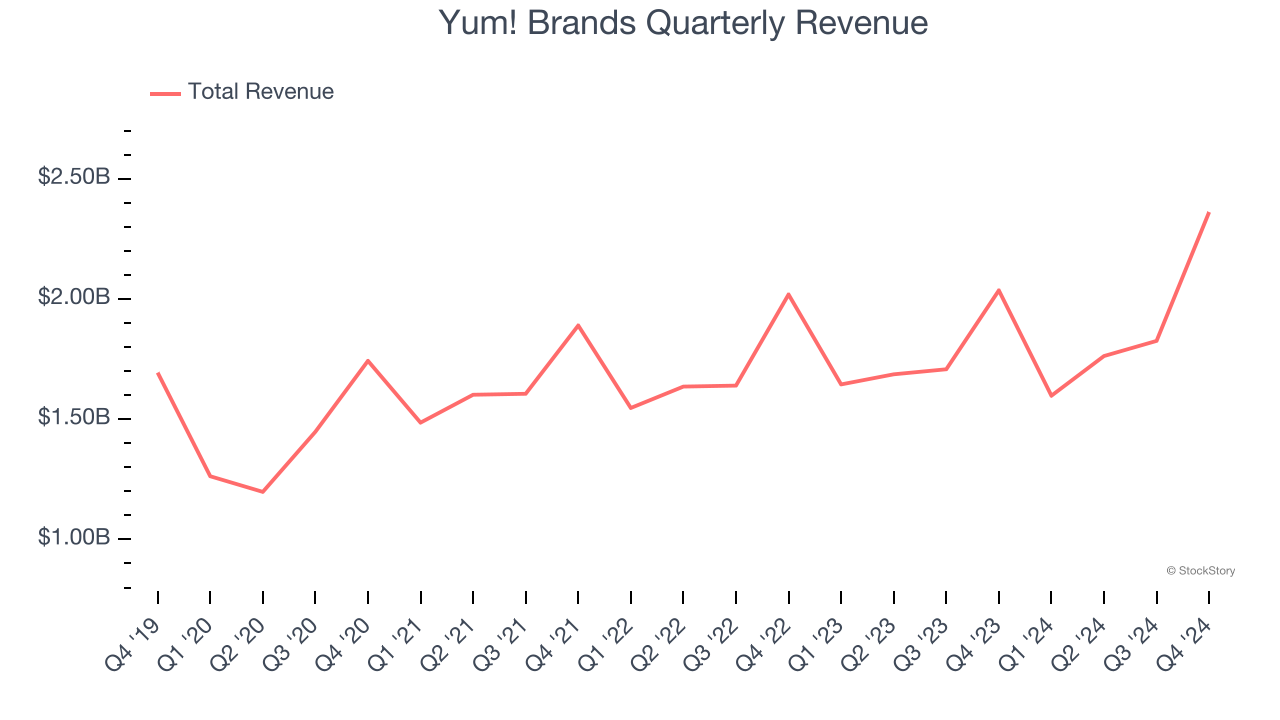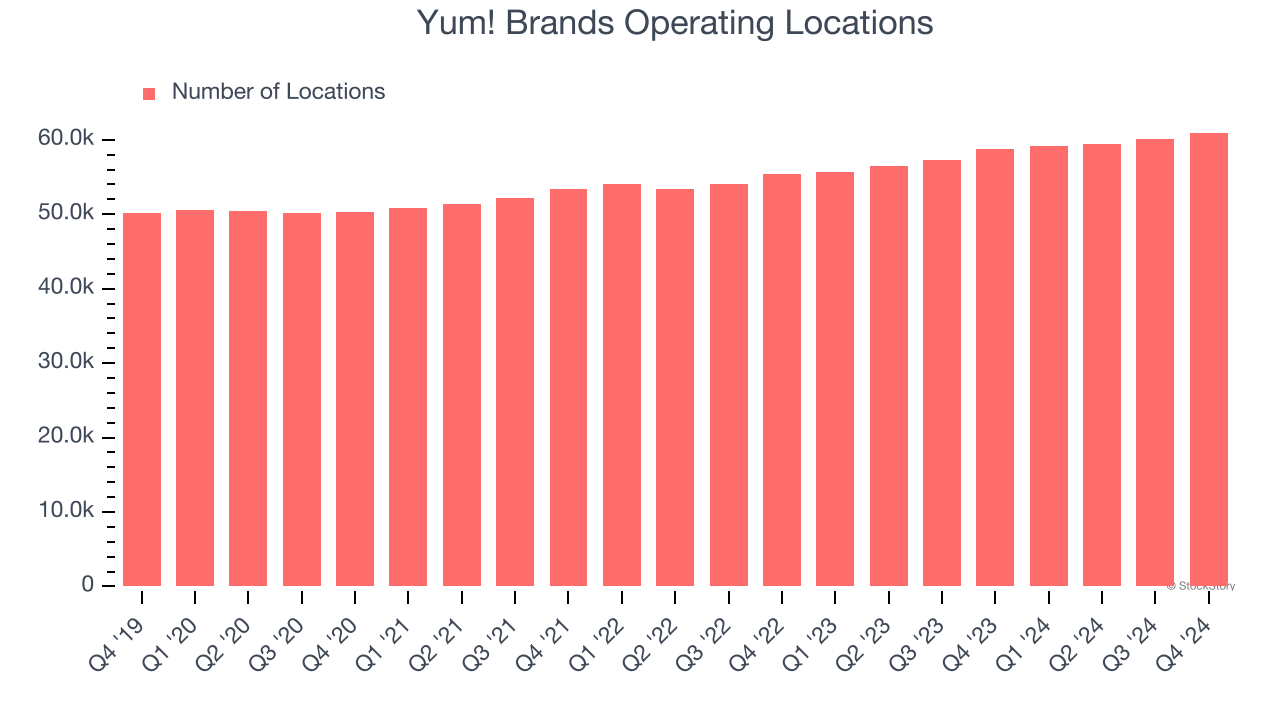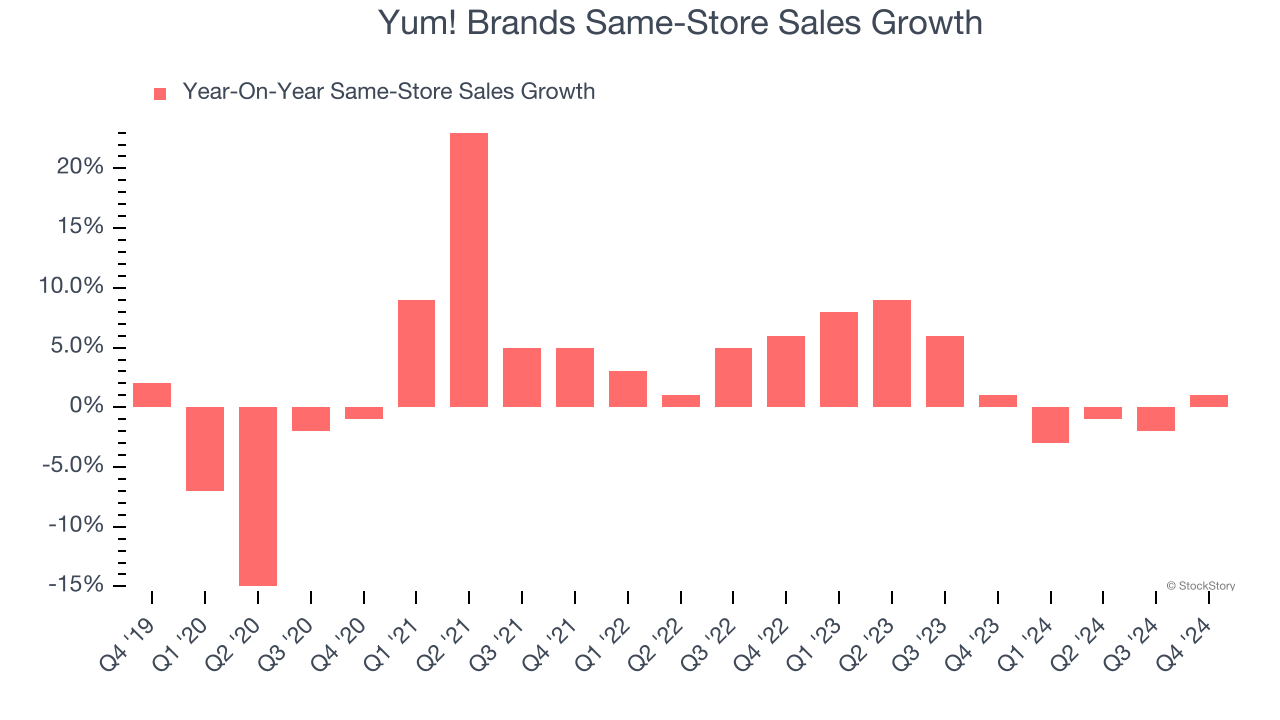
Fast-food company Yum! Brands (NYSE:YUM) met Wall Street’s revenue expectations in Q4 CY2024, with sales up 16% year on year to $2.36 billion. Its non-GAAP profit of $1.61 per share was 0.9% above analysts’ consensus estimates.
Is now the time to buy Yum! Brands? Find out by accessing our full research report, it’s free.
Yum! Brands (YUM) Q4 CY2024 Highlights:
- Revenue: $2.36 billion vs analyst estimates of $2.35 billion (16% year-on-year growth, in line)
- Adjusted EPS: $1.61 vs analyst estimates of $1.60 (0.9% beat)
- Outlook: "we expect 2025 to be another on-algorithm year for Core Operating Profit growth." (company states that this means at least 8% Core Operating Profit Growth)
- Operating Margin: 27.8%, down from 29.9% in the same quarter last year
- Free Cash Flow Margin: 17.2%, similar to the same quarter last year
- Locations: 60,963 at quarter end, up from 58,708 in the same quarter last year
- Same-Store Sales rose 1% year on year, in line with the same quarter last year
- Market Capitalization: $36.63 billion
Company Overview
Spun off as an independent company from PepsiCo, Yum! Brands (NYSE:YUM) is a multinational corporation that owns KFC, Pizza Hut, Taco Bell, and The Habit Burger Grill.
Traditional Fast Food
Traditional fast-food restaurants are renowned for their speed and convenience, boasting menus filled with familiar and budget-friendly items. Their reputations for on-the-go consumption make them favored destinations for individuals and families needing a quick meal. This class of restaurants, however, is fighting the perception that their meals are unhealthy and made with inferior ingredients, a battle that's especially relevant today given the consumers increasing focus on health and wellness.
Sales Growth
A company’s long-term performance is an indicator of its overall quality. While any business can experience short-term success, top-performing ones enjoy sustained growth for years.
With $7.55 billion in revenue over the past 12 months, Yum! Brands is larger than most restaurant chains and benefits from economies of scale, enabling it to gain more leverage on its fixed costs than smaller competitors. Its size also gives it negotiating leverage with suppliers, allowing it to source its ingredients at a lower cost. However, its scale is a double-edged sword because it's harder to find incremental growth when your existing restaurant banners have penetrated most of the market. To accelerate system-wide sales, Yum! Brands must lean into newer chains.
As you can see below, Yum! Brands grew its sales at a mediocre 6.2% compounded annual growth rate over the last five years (we compare to 2019 to normalize for COVID-19 impacts), but to its credit, it opened new restaurants and increased sales at existing, established dining locations.

This quarter, Yum! Brands’s year-on-year revenue growth was 16%, and its $2.36 billion of revenue was in line with Wall Street’s estimates.
Looking ahead, sell-side analysts expect revenue to grow 5.9% over the next 12 months, similar to its five-year rate. This projection is underwhelming and suggests its newer menu offerings will not catalyze better top-line performance yet. At least the company is tracking well in other measures of financial health.
Today’s young investors won’t have read the timeless lessons in Gorilla Game: Picking Winners In High Technology because it was written more than 20 years ago when Microsoft and Apple were first establishing their supremacy. But if we apply the same principles, then enterprise software stocks leveraging their own generative AI capabilities may well be the Gorillas of the future. So, in that spirit, we are excited to present our Special Free Report on a profitable, fast-growing enterprise software stock that is already riding the automation wave and looking to catch the generative AI next.
Restaurant Performance
Number of Restaurants
Yum! Brands operated 60,963 locations in the latest quarter. It has opened new restaurants at a rapid clip over the last two years, averaging 5.2% annual growth, much faster than the broader restaurant sector. Additionally, one dynamic making expansion more seamless is the company’s franchise model, where franchisees are primarily responsible for opening new restaurants while Yum! Brands provides support.
When a chain opens new restaurants, it usually means it’s investing for growth because there’s healthy demand for its meals and there are markets where its concepts have few or no locations.

Same-Store Sales
The change in a company's restaurant base only tells one side of the story. The other is the performance of its existing locations, which informs management teams whether they should expand or downsize their physical footprints. Same-store sales gives us insight into this topic because it measures organic growth at restaurants open for at least a year.
Yum! Brands’s demand rose over the last two years and slightly outpaced the industry. On average, the company’s same-store sales have grown by 2.4% per year. This performance suggests its rollout of new restaurants could be beneficial for shareholders. When a chain has demand, more locations should help it reach more customers and boost revenue growth.

In the latest quarter, Yum! Brands’s same-store sales rose 1% year on year. This was a meaningful deceleration from its historical levels. We’ll be watching closely to see if Yum! Brands can reaccelerate growth.
Key Takeaways from Yum! Brands’s Q4 Results
It was good to see Yum! Brands meet analysts’ same-store sales expectations this quarter, leading to in-line revenue. On the bottom line, EPS beat slightly. While there was no specific 2025 guidance, management noted that this year should be another one following their long-term growth algorithm. Overall, this was a fine quarter with no major surprises. The stock traded up 1.9% to $133.74 immediately after reporting.
Should you buy the stock or not? We think that the latest quarter is only one piece of the longer-term business quality puzzle. Quality, when combined with valuation, can help determine if the stock is a buy. We cover that in our actionable full research report which you can read here, it’s free.
